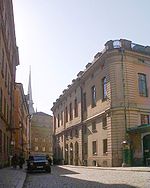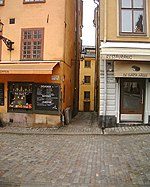Gamla stan
Districts of StockholmTourist attractions in Stockholm

Gamla stan (Swedish: [ˈɡâmːla ˈstɑːn], "The Old Town"), until 1980 officially Staden mellan broarna ("The Town between the Bridges"), is the old town of Stockholm, Sweden. Gamla stan consists primarily of the island Stadsholmen. Officially, but not colloquially, Gamla stan includes the surrounding islets Riddarholmen, Helgeandsholmen and Strömsborg. It has a population of approximately 3,000. Notable buildings, located in the old town, include, among others, the Bonde Palace, Stockholm Palace, Stockholm Stock Exchange Building and Tessin Palace.
Excerpt from the Wikipedia article Gamla stan (License: CC BY-SA 3.0, Authors, Images).Gamla stan
Stortorget, Stockholm Gamla stan (Södermalms stadsdelsområde)
Geographical coordinates (GPS) Address Nearby Places Show on map
Geographical coordinates (GPS)
| Latitude | Longitude |
|---|---|
| N 59.325 ° | E 18.070833333333 ° |
Address
Stortorget
Stortorget
Stockholm, Gamla stan (Södermalms stadsdelsområde)
Sweden
Open on Google Maps











